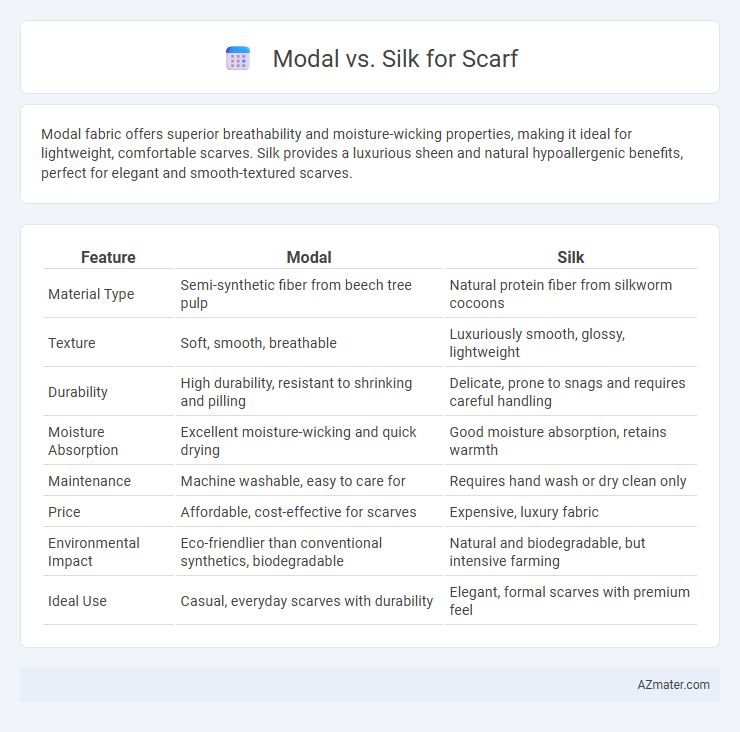Modal fabric offers superior breathability and moisture-wicking properties, making it ideal for lightweight, comfortable scarves. Silk provides a luxurious sheen and natural hypoallergenic benefits, perfect for elegant and smooth-textured scarves.
Table of Comparison
| Feature | Modal | Silk |
|---|---|---|
| Material Type | Semi-synthetic fiber from beech tree pulp | Natural protein fiber from silkworm cocoons |
| Texture | Soft, smooth, breathable | Luxuriously smooth, glossy, lightweight |
| Durability | High durability, resistant to shrinking and pilling | Delicate, prone to snags and requires careful handling |
| Moisture Absorption | Excellent moisture-wicking and quick drying | Good moisture absorption, retains warmth |
| Maintenance | Machine washable, easy to care for | Requires hand wash or dry clean only |
| Price | Affordable, cost-effective for scarves | Expensive, luxury fabric |
| Environmental Impact | Eco-friendlier than conventional synthetics, biodegradable | Natural and biodegradable, but intensive farming |
| Ideal Use | Casual, everyday scarves with durability | Elegant, formal scarves with premium feel |
Introduction to Modal and Silk Scarves
Modal scarves are crafted from semi-synthetic fibers derived from beech tree pulp, offering exceptional softness, breathability, and moisture-wicking properties ideal for sensitive skin. Silk scarves, made from natural protein fibers produced by silkworms, provide a luxurious, smooth texture with natural sheen and excellent temperature regulation, making them perfect for both warmth and elegance. Choosing between Modal and Silk scarves depends on preferences for eco-friendliness, durability, and the desired tactile experience.
What is Modal?
Modal is a semi-synthetic fiber made from beech tree pulp that offers exceptional softness and breathability, making it ideal for scarves. It is highly absorbent and resistant to shrinkage, maintaining its luxurious feel even after multiple washes. Compared to silk, Modal provides more durability and wrinkle resistance, combining comfort with practical wearability.
What is Silk?
Silk is a natural protein fiber produced by silkworms, prized for its smooth texture, vibrant sheen, and exceptional breathability. It offers excellent moisture-wicking properties, making silk scarves comfortable to wear in various climates. Compared to Modal, silk provides a luxurious feel and natural hypoallergenic benefits, enhancing both style and comfort in scarf materials.
Key Differences: Modal vs Silk
Modal scarves offer superior breathability and moisture-wicking properties compared to silk, making them ideal for humid climates and active wear. Silk scarves provide a luxurious sheen and natural temperature regulation but require delicate care due to their fragility. Modal fabric is more durable, resistant to shrinkage and fading, while silk remains prized for its smooth texture and elegant drape in high-end fashion.
Texture and Feel: Comfort Comparison
Modal scarves offer a smooth, silky texture with a lightweight feel that drapes effortlessly around the neck, providing exceptional softness and breathability. Silk scarves boast a luxuriously smooth surface with a natural sheen, creating a cool, slippery touch that feels elegant yet delicate on the skin. Both fabrics deliver superior comfort, with Modal excelling in moisture absorption and durability, while Silk provides a more refined, classic sensation ideal for formal wear.
Durability: Which Lasts Longer?
Modal fabric offers superior durability for scarves due to its resistance to shrinking, pilling, and fading, making it ideal for long-term use. Silk, while luxurious and smooth, is more delicate and prone to damage from friction, sunlight, and washing, which can reduce its lifespan. For scarves intended for frequent wear, Modal provides a longer-lasting option without sacrificing softness and drape.
Breathability and Moisture Management
Modal fabric excels in breathability due to its semi-synthetic cellulose fibers that allow air to circulate freely, making it ideal for scarves worn in warmer climates. Its moisture management capabilities are superior, as Modal efficiently absorbs and wicks away sweat, keeping the skin dry and comfortable throughout the day. In contrast, Silk offers moderate breathability and moisture control but tends to retain dampness longer, which may result in reduced comfort during intense physical activity or hot weather.
Maintenance and Care Tips
Modal scarves require gentle hand washing with mild detergent to maintain their softness and prevent shrinking, while air drying is recommended to avoid damage from high heat. Silk scarves are best cleaned through professional dry cleaning or delicate hand washing with cold water and a gentle silk-specific detergent to preserve their natural sheen and texture. Storing both fabrics away from direct sunlight and in a breathable fabric bag helps prevent fading and fabric deterioration.
Eco-Friendliness: Sustainability Impact
Modal fabric is produced from beech tree pulp, requiring less water and energy compared to traditional silk production, making it more eco-friendly and sustainable for scarf manufacturing. Silk production involves sericulture, which demands significant water, mulberry cultivation, and energy, contributing to a higher environmental footprint. Both materials offer biodegradability, but modal's renewable sourcing and lower resource consumption position it as a greener choice in eco-conscious scarf design.
Choosing the Best Fabric for Your Scarf
Modal fabric offers exceptional softness, durability, and moisture-wicking properties, making it ideal for scarves that require breathability and ease of care. Silk, celebrated for its luxurious texture and natural sheen, provides excellent insulation and a lightweight feel, perfect for elegant and formal scarf designs. Choosing between Modal and Silk depends on whether you prioritize long-lasting performance and easy maintenance or a premium, glossy appearance with delicate care requirements.

Infographic: Modal vs Silk for Scarf
 azmater.com
azmater.com